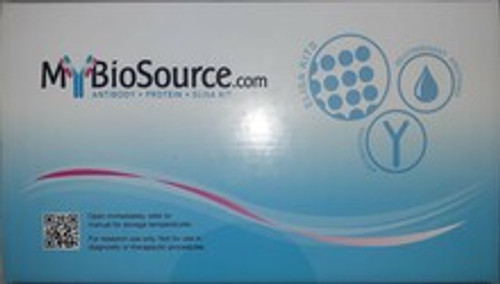Product Description
Recombinant Human SWI/SNF-related matrix-associated actin-dependent regulator of chromatin subfamily B member 1 (SMARCB1), partial is available at Gentaur for Next week Delivery.
Gene Name: SMARCB1
Alternative Names : BRG1-associated factor 47 (BAF47) (Integrase interactor 1 protein) (SNF5 homolog) (hSNF5) (BAF47) (INI1) (SNF5L1)
Expression Region : 2-376aa
AA Sequence : MMMALSKTFGQKPVKFQLEDDGEFYMIGSEVGNYLRMFRGSLYKRYPSLWRRLATVEERKKIVASSHGKKTKPNTKDHGYTTLATSVTLLKASEVEEILDGNDEKYKAVSISTEPPTYLREQKAKRNSQWVPTLPNSSHHLDAVPCSTTINRNRMGRDKKRTFPLCFDDHDPAVIHENASQPEVLVPIRLDMEIDGQKLRDAFTWNMNEKLMTPEMFSEILCDDLDLNPLTFVPAIASAIRQQIESYPTDSILEDQSDQRVIIKLNIHVGNISLVDQFEWDMSEKENSPEKFALKLCSELGLGGEFVTTIAYSIRGQLSWHQKTYAFSENPLPTVEIAIRNTGDADQWCPLLETLTDAEMEKKIRDQDRNTRRMR
Sequence Info : Partial
Tag Info : N-terminal 6xHis-tagged
Theoretical MW : 49.0 kDa
Storage Buffer : Tris/PBS-based buffer, 5%-50% glycerol. If the delivery form is lyophilized powder, the buffer before lyophilization is Tris/PBS-based buffer, 6% Trehalose, pH 8.0.
Endotoxin Level : Not tested-
Biological Activity : Not tested
Storage : Short term: -20°C; Long term: -80°C. Minimize freeze and thaw cycles.
Research Area : Cancer
Restriction : For Research Use Only. Not for use in diagnostic procedures, drug use, or for administration to humans or animals.
Relevance : Core component of the BAF complex. This ATP-dependent chromatin-remodeling complex plays important roles in cell proliferation and differentiation, in cellular antiviral activities and inhibition of tumor formation. The BAF complex is able to create a stable, altered form of chromatin that constrains fewer negative supercoils than normal. This change in supercoiling would be due to the conversion of up to one-half of the nucleosomes on polynucleosomal arrays into asymmetric structures, termed altosomes, each composed of 2 histones octamers. Stimulates in vitro the remodeling activity of SMARCA4/BRG1/BAF190A. Involved in activation of CSF1 promoter. Belongs to the neural progenitors-specific chromatin remodeling complex and the neuron-specific chromatin remodeling complex. During neural development a switch from a stem/progenitor to a postmitotic chromatin remodeling mechanism occurs as neurons exit the cell cycle and become committed to their adult state. The transition from proliferating neural stem/progenitor cells to postmitotic neurons requires a switch in subunit composition of the npBAF and nBAF complexes. As neural progenitors exit mitosis and differentiate into neurons, npBAF complexes which contain ACTL6A/BAF53A and PHF10/BAF45A, are exchanged for homologous alternative ACTL6B/BAF53B and DPF1/BAF45B or DPF3/BAF45C subunits in neuron-specific complexes. The npBAF complex is essential for the self-renewal/proliferative capacity of the multipotent neural stem cells. The nBAF complex along with CREST plays a role regulating the activity of genes essential for dendrite growth. Plays a key role in cell-cycle control and causes cell cycle arrest in G0/G1.
Function : Core component of the BAF (hSWI/SNF) complex. This ATP-dependent chromatin-remodeling complex plays important roles in cell proliferation and differentiation, in cellular antiviral activities and inhibition of tumor formation. The BAF complex is able to create a stable, altered form of chromatin that constrains fewer negative supercoils than normal. This change in supercoiling would be due to the conversion of up to one-half of the nucleosomes on polynucleosomal arrays into asymmetric structures, termed altosomes, each composed of 2 histones octamers. Stimulates in vitro the remodeling activity of SMARCA4/BRG1/BAF190A. Involved in activation of CSF1 promoter. Belongs to the neural progenitors-specific chromatin remodeling complex (npBAF complex) and the neuron-specific chromatin remodeling complex (nBAF complex). During neural development a switch from a stem/progenitor to a postmitotic chromatin remodeling mechanism occurs as neurons exit the cell cycle and become committed to their adult state. The transition from proliferating neural stem/progenitor cells to postmitotic neurons requires a switch in subunit composition of the npBAF and nBAF complexes. As neural progenitors exit mitosis and differentiate into neurons, npBAF complexes which contain ACTL6A/BAF53A and PHF10/BAF45A, are exchanged for homologous alternative ACTL6B/BAF53B and DPF1/BAF45B or DPF3/BAF45C subunits in neuron-specific complexes (nBAF). The npBAF complex is essential for the self-renewal/proliferative capacity of the multipotent neural stem cells. The nBAF complex along with CREST plays a role regulating the activity of genes essential for dendrite growth (By similarity). Plays a key role in cell-cycle control and causes cell cycle arrest in G0/G1.
Involvement in disease : Rhabdoid tumor predisposition syndrome 1 (RTPS1); Schwannomatosis 1 (SWNTS1); Coffin-Siris syndrome 3 (CSS3)
Subcellular location : Nucleus
Protein Families : SNF5 family
Tissue Specificity :
Paythway :
Uniprot ID : Q12824
 Euro
Euro
 British Pound
British Pound
 US Dollar
US Dollar








